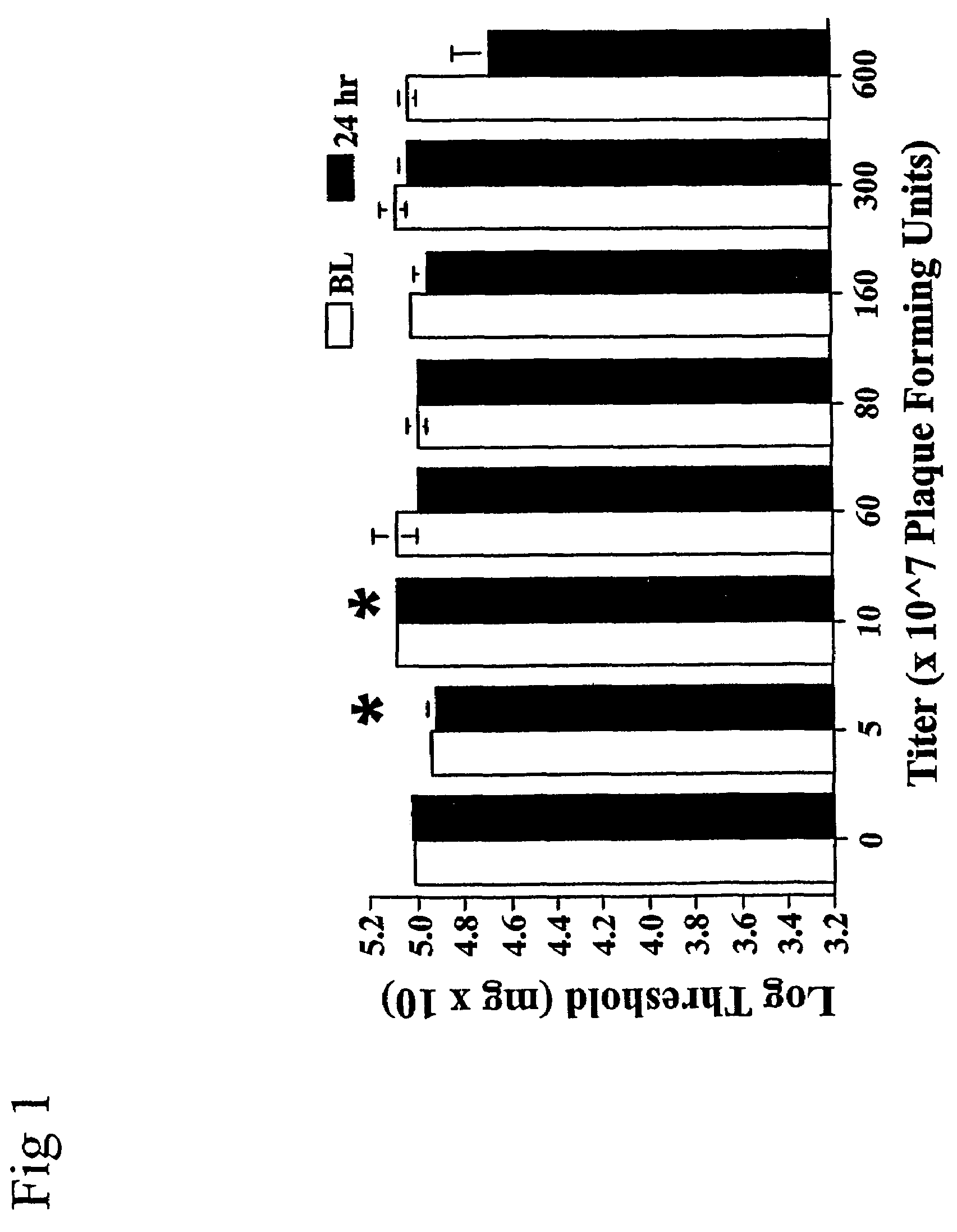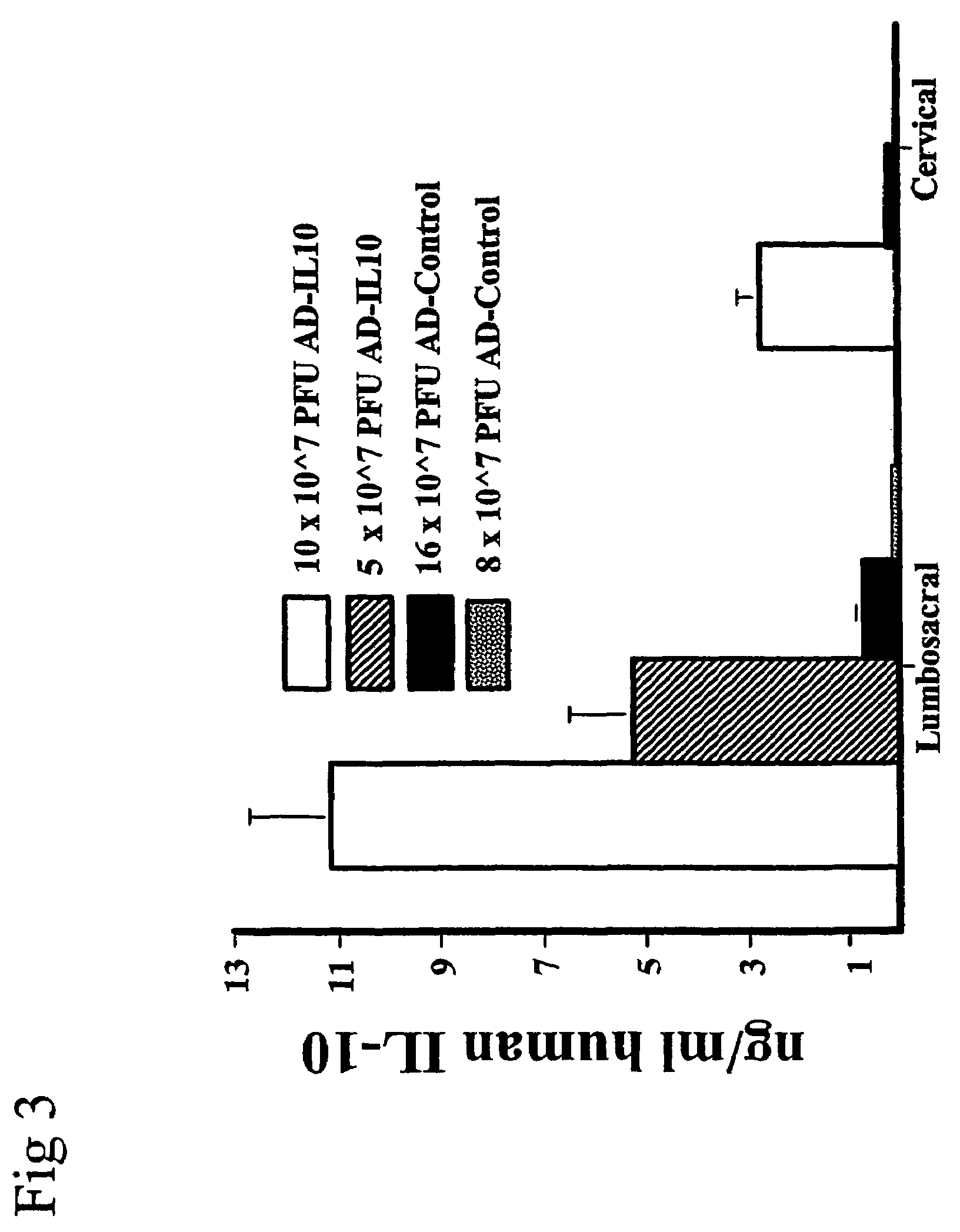Methods for treating neuropathic pain by administering IL-10 polypeptides
a neuropathic pain and polypeptide technology, applied in the field of gene delivery methods, can solve the problems of short half life, difficult systemic delivery of il-10 to treat cns disorders, and only recently used gene therapy in attempts, so as to prevent and reverse pain
- Summary
- Abstract
- Description
- Claims
- Application Information
AI Technical Summary
Benefits of technology
Problems solved by technology
Method used
Image
Examples
example 1
Dose Response Characterization of Intrathecal Adenovirus Effects on Behavioral Sensitivity to Calibrated Touch / Pressure Stimuli
[0246]The following experiment was conducted in order to define a range of adenovirus doses that produced no apparent change in threshold responses to calibrated touch / pressure stimuli. After assessment of baseline von Frey responses, rats were intrathecally injected with either 0 (n=7), 5 (n=5), 10 (n=5), 60 (n=2), 80 (n=7), 160 (n=4), 300 (n=2), or 600 (n=2)×107 plaque forming units (PFU) of adenovirus. Testing of 1200×107 PFU was attempted but terminated upon observing vestibulomotor effects of this dose. Rats injected intrathecally with adenovirus were assessed on the von Frey test 24 hr later.
[0247]While doses of adenovirus up to 300×107 PFU had no reliable effect on responses to calibrated touch / pressure stimuli compared to vehicle controls, the highest dose (600×107 PFU) lowered the response threshold (FIG. 1). Pre-viral-injected BL values showed no r...
example 2
Prevention of Intrathecal HIV-1 gp120 Induced Mechanical Allodynia by Intrathecal AD-IL10
[0248]It has previously been shown that spinal immune activation induced by intrathecal delivery of gp120, an envelope glycoprotein of human immunodeficiency virus-I, lowers the response threshold to touch / pressure stimuli (Milligan et al., Brain Res. (2000) 861:105-116; Milligan et al., J. Neurosci. (2001) 21:2808-2819). This pain response is the result of spinal cord glial activation and the release of the glial proinflammatory cytokines IL1 and TNF (Milligan et al., Brain Res. (2000) 861:105-116; Milligan et al., J. Neurosci. (2001) 21:2808-2819). Hence the ability of AD-IL10 to prevent this glially-driven mechanical allodynia was examined.
[0249]Based on pilot studies of adenoviral doses within the range defined in Example 1, 10×107 PFU of AD-IL10 in 10 μl was chosen for study. An equal volume of AD-Control (16×107 PFU in 10 μl) was administered to the control group. Rats were first assessed ...
example 3
Prevention of Sciatic Inflammatory Neuropathy (SIN) Induced Mechanical Allodynia by Intrathecal AD-IL10
[0252]The purpose of Examples 3 through 5 was to extend the results of Example 2 by examining the effect of AD-IL10 on neuropathic pain. Neuropathic pain arises as a consequence of inflammation and / or trauma of peripheral nerves. Neuropathic pain is poorly managed by currently available drugs developed to target neurons (for review, see (Watkins and Maier, Physiol. Rev. (2002) 82:981-1011).
[0253]AD-IL10 was tested for its ability to prevent mechanical allodynia induced by sciatic inflammatory neuropathy (SIN) as follows. Based on pilot studies of adenoviral doses within the range defined in Example 1, 5×107 PFU of AD-IL10 in 5 μl was chosen for study. An equal volume of AD-Control (8×107 PFU in 5 μl) was administered to the control group. Rats were first assessed for their responses to the von Frey test prior to (BL) and again on Day 4 after intrathecal AD-IL10 or AD-Control inject...
PUM
| Property | Measurement | Unit |
|---|---|---|
| concentration | aaaaa | aaaaa |
| time | aaaaa | aaaaa |
| time | aaaaa | aaaaa |
Abstract
Description
Claims
Application Information
 Login to View More
Login to View More - R&D
- Intellectual Property
- Life Sciences
- Materials
- Tech Scout
- Unparalleled Data Quality
- Higher Quality Content
- 60% Fewer Hallucinations
Browse by: Latest US Patents, China's latest patents, Technical Efficacy Thesaurus, Application Domain, Technology Topic, Popular Technical Reports.
© 2025 PatSnap. All rights reserved.Legal|Privacy policy|Modern Slavery Act Transparency Statement|Sitemap|About US| Contact US: help@patsnap.com



